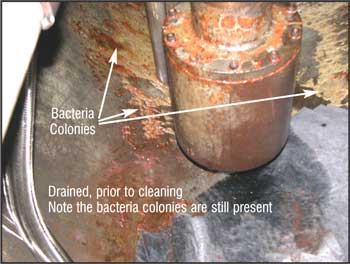- Home
- About
- Services
- Air Blow Cleaning Services
- Oil Filtration Services
- Chemical Cleaning
- Filters & Breathers
- Fluid Reconditioning Services
- Hydraulic System Decontamination
- Hydrolazing
- Hydrostatic Testing
- Oil Flushing
- MHC & EHC Flushing
- Reservoir and Tank Cleaning
- Steam Blowing
- Varnish Mitigation & Removal
- Additional Services
- Equipment Fleet
- Our Brands
- Projects
- Get A Quote
- Contact
Preventing Bacterial Growth in Your Turbine
Bacteria colonies are a growing and expensive problem
As steam turbines throughout the United States age and maintenance intervals are pushed out, preventing bacteria growth inside turbines is becoming ever more important. Bacteria colonies can affect oil quality, produce corrosive by products, and clog control systems which can result in significant repair costs.
There are three main types of bacteria that grow in lube oil systems:
- Sulfate Reducing Bacteria (SRB), which are anaerobic bacteria that survive off sulfate
- Acid Producing Bacteria (APB), also anaerobic and ferment sugars, usually light organic acids
- General Aerobic Bacteria (GAB), which require oxygen to survive and grow
Specific conditions must exist for the bacteria to develop and grow. Water must be present, but as little as 0.5 mL of water per Liter of turbine oil can do the trick. Organic material (carbon, nitrogen, phosphorous), optimum temperatures, stagnant or low flow areas of the system, suspended particles, and emulsification of the oil are the other key ingredients. The presence of oxygen will act as a accelerant, speeding up bacteria growth. But how do you know if these conditions have developed in your turbine?
Operational Signs of Bacterial Growth
Lab analysis is the best way to confirm the presence of bacteria and the only way to know which type you have. But, there are some other signs and symptoms you can look for:
- Do you see any clear, silicone colored gel inside the site glass of your oil filtration skid?
- Are your filters frequently plugged with a jelly substance? What about your control orifices or lines?
- Are you controls slow to respond or under responding? Have you had a unit trip recently?
- Have you been operating for prolonged periods with water levels greater than 500 ppm?
- Are you seeing emulsified oil or an oil/water mix that will not easily separate?
- Has your turbine failed any of these tests recently?
- Water demulsification test (ASTM D1401)
- Turbine oil foaming characteristics test (ASTM D892)
- Relatively rapid turbine oil oxidation as measured by the RPVOT test (ASTM D2272), especially if the oil has not been overheated
- Do you see any isolated, concentrated rust spots on metal parts of filter ends, turbine bearing components, and so on?
How to Remove Bacteria from Your Turbine
If you do suspect you have a problem, or even if you just want peace of mind and simple want to check, here’s what you should do.
- Confirm the presence and type of bacteria with the help of a fluid analysis lab. Don’t know a good lab? We can help with that. Simply call us at 1-800-770-4510 and we can be on-site within 24 hours or less.
- Remove the contaminated oil. Do not use in-plant piping during the oil removal – this will only increase the risk of spreading the bacteria.
- Inspect and clean the lube oil systems, dissembling and cleaning major components, especially reservoirs and filter housings.
- Have a high volume, high temperature oil flush performed on the system. Do not use old oil for this flush! Bacteria, bacteria, bacteria!
- Refill the system with new oil
- Add recommended biocide to the lube oil


